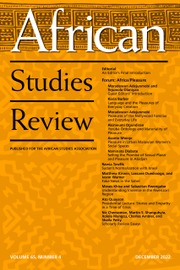On its surface, the film Didy (2024), is an orphan’s search for a mother lost to the AIDS epidemic during the late 1980s and early 1990s. Written and directed by Swiss filmmakers Gaël Kamilindi and François-Xavier Destors, the film documents Kamilindi’s search for memories of his mother, Didy, among the few remaining family members and friends who knew her in Rwanda, Burundi, and Democratic Republic of the Congo. At its heart, Didy is an act of mourning that underscores the human need to grieve through ritual and ceremony. The film touches on the many calamities that rocked the African Great Lakes region, including political violence against the Tutsi in 1970s Rwanda, civil war in Burundi in the 1990s, the HIV/AIDS pandemic, and the 1994 genocide against the Tutsi in Rwanda. The directors’ original approach blending interviews, artifacts, and staged scenes brings viewers on an emotional journey as Kamilindi uncovers his origins and a mother lost to tragedies on a global scale.
Born in the Democratic Republic of Congo, Kamilindi is an actor and filmmaker of Swiss nationality. He graduated from the National Conservatory of Dramatic Arts in Paris in 2011 and has been a member of the troupe at the Comédie-Française since 2017. He is among a generation of Diasporic artists with origins in Rwanda whose work explores the meanings of home and homeland for Black artists living in Europe. In Didy, Kamilindi’s directorial debut, he explores the existential pain shared by those exiled from the African Great Lakes and the intergenerational trauma provoked by the region’s serial calamities.
Kamilindi was only five years old when his mother passed away. Shortly before her death, his mother sent him to live with her sister’s family in Switzerland. Thirty years later, Kamilindi goes in search of his family history and the mother he barely remembers, returning to Rwanda and Burundi to interview the men and women who knew his mother. From each, he recovers missing fragments of Didy from those who loved and guided her. In the 1970s, she was imprisoned in Rwanda for a poem she wrote while in high school. After her release, she fled to Burundi along with many Rwandan Tutsis fleeing political violence and oppression. Then, Didy fled again to escape civil war in Burundi in the 1980s and make her own way through life in Kinshasa free from family oversight.
The film’s middle section departs from the heavy emotional core of the film. Driven primarily by interviews with his mother’s friends, Kamilindi depicts a generation of Rwandan women who lived life on their own terms while surviving the worst. Working days in offices, they lived a life of freedom, music, dancing, and parties at night. In their own words, these so-called “femmes libres” (loose women) describe themselves as “liberated women” and “libertines” who lived life to its fullest.
From the film’s opening moments, Kamilindi and Destors evoke the film’s emotional heart by uniting music and visual imagery. It opens with a title screen in black, listing the names of those appearing in the film in white lettering while the song “Nibarize” (2011) by Jacques Murigande (aka Mighty Popo) plays. Murigande sings in a whispering melodic style typical of Rwandan traditional music to accompany the inanga, a stringed instrument played in Rwanda, Burundi, Uganda, and parts of Democratic Republic of Congo. In the song’s title and refrain, Muriganda repeatedly murmurs, “Nibarize [Teach me].” From the darkness, Kamilindi emerges using his cellphone flashlight to search through sacks. He finds an old photo album, opens it, and smiles as he looks at the pages featuring his mother, relatives, and himself as a toddler. The song’s lamenting style sets the tone for the film and evokes its central theme where past, present, and future exist in the same moment.
Through his art, Kamilindi resurrects his mother in his friend, actor Kayije Kagame, who like him, grew up in exile from Rwanda, their motherland. In one scene, Kamilindi asks Kagame to reenact a photo of Didy from her youth in Kinshasa. Kagame and Kamilindi marvel at the final product where Kagame captures Didy’s physical appearance and emotional essence. Creative scenes interspersed throughout the film’s interviews and family photographs portray Kagame as Didy and as a mythical motherly figure representing motherland. In the film’s final scenes Kagame bathes Kamilindi in a lake surrounded by mountains—a symbolic rebirth of Kamilindi as a child of the African Great Lakes. This scene and the film as a whole mobilizes African aesthetics and draws on Rwandan mourning rituals featuring fire, smoke, and ashes.
This film is highly recommended for audiences interested in creative documentary, African or African diaspora filmmaking, intergenerational trauma, or the long-term legacies of civil war, genocide, or the HIV pandemic in Africa. Viewers from or with ties to the African Great Lakes should be prepared for a deeply emotional journey and catharsis. The film’s deliberately slow pace and narrative style make the film less suitable for teaching outside of courses focused on film or literature.

